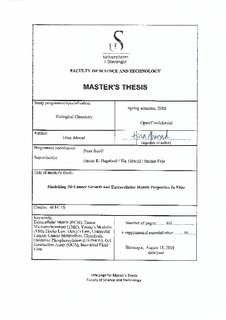| dc.contributor.advisor | Hagland, Hanne R. | |
| dc.contributor.author | Ahmad, Hina | |
| dc.date.accessioned | 2018-10-15T09:01:38Z | |
| dc.date.available | 2018-10-15T09:01:38Z | |
| dc.date.issued | 2018-08-15 | |
| dc.identifier.uri | http://hdl.handle.net/11250/2567955 | |
| dc.description | Master's thesis in Biological Chemistry | nb_NO |
| dc.description.abstract | Background: Cancer can be defined as loss of normal behavior of cellular components thus losing tissue organization and giving rise to a tumor microenvironment (TME). Increased matrix stiffness, strain and elevated interstitial fluid flow and/or pressure of extracellular matrix (ECM) in TME is characterized as the cause of initiation and progression of tumorigenesis. The purpose of this study is to develop an understanding of physical and mechanical forces that contribute in remodeling of extracellular matrix in a cancerous environment to promote cancer development using a 3D cell culture model with collagen to mimic in-vivo microenvironment.
Methods: Type I collagen was used to create a 3D model to investigate the mechanical properties under various conditions like changes in concentration, polymerization pH and temperature, and presence of colorectal cancer cell lines, SW948 and SW1116, were used that exhibit differential metabolic phenotypes. Co-culture with fibroblast, CCD-18Co was evaluated to recapitulate the stromal environment that the cells encounter in vivo to elucidate the changes ECM go through during tumor progression. A microfluidic cell culture system was used to apply fluid flow and pressure gradient to a 3D collagen scaffold to understand the role of interstitial flow in matrix organization, cancer growth and migration during cancer progression.
Results: Mechanical testing of acellular collagen showed Youngs’s Modulus of 44 KPa in 2 mg/ml while 88 KPa in 4 mg/ml collagen gel. Collagen with polymerization pH range of 7.4-6.1 showed a 73% decrease in collagen stiffness in 2 mg/ml acellular collagens while 26% decrease in 4 mg/ml sample. Independent co-culture with fibroblast (CCD-18Co) of cancer cells SW948 and SW1116 showed an increase in YM by 39% and 37% in 2mg/ml collagen while a decrease in YM by 85% and 43% respectively in 4 mg/ml gel. Fibroblast mono-culture gel showed most contraction (79%) in 2 mg/ml while among cancer cells, co-cultured SW1116 (78%) with fibroblast showed most contraction then SW948 (60%) in 2 mg/ml sample. Highest cell migration under normal interstitial flow with fibroblast embedded collagen resulting in 734 migrated cell of SW948 and 350 cells of SW1116.
Conclusions: The study has established that pure biophysical forces from cancer or fibroblast cells can optimize the mechanical properties of extracellular matrix. Youngs’s Modulus increased with increasing gel concentration. Collagen cancer and fibroblast co-cultured gel showed an increase in stiffness in 2mg/ml collagen while a decrease in YM in 4 mg/ml gel. Gel contraction assay showed highest contraction in fibroblast mono-culture gel samples while SW1116 gel co-cultured with fibroblast showed most contraction. Highest cell migration was observed by SW948 under normal flow with fibroblast embedded 2 mg/ml collagen. I summary it can be conclude that it is important to consider both tumor microenvironment and phenotype of cancer cells when considering regulation of extracellular matrix. | nb_NO |
| dc.language.iso | eng | nb_NO |
| dc.publisher | University of Stavanger, Norway | nb_NO |
| dc.rights | Attribution-NonCommercial-NoDerivatives 4.0 Internasjonal | * |
| dc.rights.uri | http://creativecommons.org/licenses/by-nc-nd/4.0/deed.no | * |
| dc.subject | biologisk kjemi | nb_NO |
| dc.subject | kreft | nb_NO |
| dc.subject | 3D-modell | nb_NO |
| dc.title | Modeling 3D cancer growth and extracellular matrix properties in vitro | nb_NO |
| dc.type | Master thesis | nb_NO |
| dc.subject.nsi | VDP::Matematikk og Naturvitenskap: 400::Kjemi: 440 | nb_NO |
| dc.subject.nsi | VDP::Matematikk og Naturvitenskap: 400::Basale biofag: 470::Biokjemi: 476 | nb_NO |

